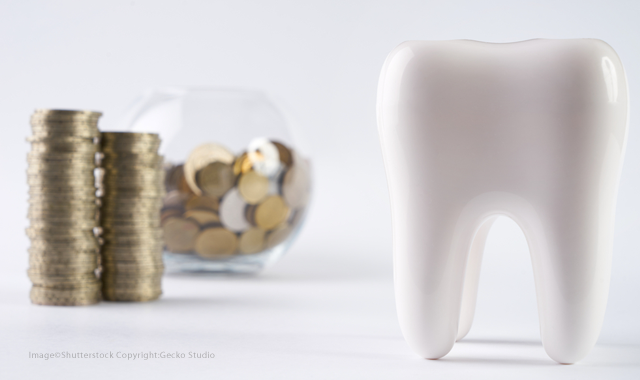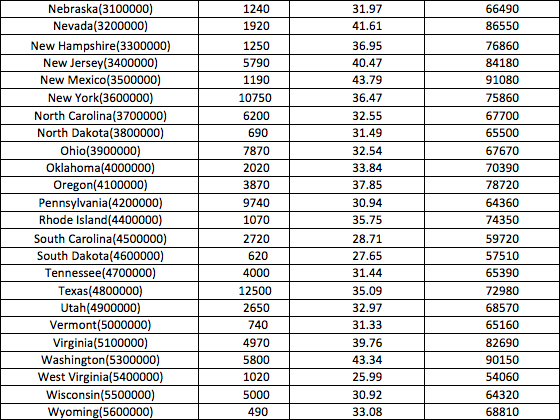The latest hourly and annual salary numbers for dental hygienists
Looking at the most recent data from the US Bureau of Labor Statistics – and what it means to you. When you look around a dentist’s office, you see more dental hygienists and dental assistants than you do actual dentists.

When you look around a dentist’s office, you see more dental hygienists and dental assistants than you do actual dentists.
And with more than 100,000 dentists in the country, this should tell you something about how prevalent jobs are for hygienists. And when we tell you that job for those 100,000 dentists are expected to increase almost 20 percent by 2024, you can draw some conclusions about what that means for hygienists.
Related reading: See how the 2014 numbers compare to today's
By the numbers
Since the government’s last analysis in 2014, there has been an almost five percent growth in the career – increasing from 200,500 to 204,990. By 2024, the Bureau of Labor Statistics expects the number of dental hygienists to increase by 19 percent to 37,4000.
The average salary for dental hygienists rose about two percent from $71,970 in 2014 to $73,440 in 2016. That is an hourly rate of $35.31. (source: www.bls.gov/oes/current/oes292021.htm#st).
When we look at the entire dental team, hygienists represent a large population (they’re not as numerous as dental assistants, of course, but still a large force). There were a little more than 100,000 dentists, 327,000 dental assistants and 37,000 lab technicians.
Trending article: The best and worst states to work in a dental practice
In terms of pay, when compared to the rest of the dental team, dental hygienists fall somewhere near the middle- to upper-end. At the top, dentists make a little over $76.81 per hour on average (around $159,770 annually), while dental assistants make (on average) $17.76 per hour or $36,940 annually. Dental Lab Techs make $19.59 per hour, or $40,760 per year.
The term “annual salary” might be somewhat misleading, however, because according to the research, about half of dental hygienists worked part time and dentists often hire hygienists to work only a few days a week, so some hygienists work for more than one dentist. Nearly all dental hygienists worked in dentists’ offices, but a small number of hygienists worked in other settings, including physicians’ offices, outpatient clinics and schools.
Next: Where are hygienists making the most?
Where they are
By far and away the state with the most dental hygienists was California, where 21,490 hygienists work. Texas was a distant second with 12,500 and Florida, third, with 11,010.

Interestingly, the metropolitan areas with the highest concentrations of hygienists do not mirror the state list. The New York-Jersey City-White Plains region had the most with 6,670. It seems that more than half of Illinois’s dental hygienists work in the Chicago-Naperville-Arlington Heights region. That area came in second with 4,670. (In the state rankings, Illinois came in seventh with 8,250 hygienists in the entire state). The Los Angeles metropolitan area came in a close third with 4,660.
Trending article: The states with the best and worst dental health
The data gets a little more noteworthy when we look at how much money hygienists earned, based on where they live. There might be a reason that so many hygienists have flocked to California, beyond the sun. On average, they earned $94,640 per year, or $45.50 per hour. However, that’s not where hygienists got paid the most. The 480 hygienists in Alaska earn $49.47 per hour – or $102,890 per year.
At the bottom of the pay scale, however, the 1,020 hygienists who worked in West Virginia made $21,52 per hour ($54,060 per year) while the 3,380 hygienists in Alabama made $21.52 per hour ($44,760 per year).
Next: What does the future look like?
Plenty of work
Anyone studying hygiene at dental school need not worry about the work being there when they graduate – it will. Employment of dental hygienists is projected to grow 19 percent from 2014 to 2024, much faster than the average for all occupations. This, not surprisingly, goes hand-in-hand with a similar increase in dental career growth. Obviously, if there is going to be a growth in the number of dentists, the amount of hygienists will need to keep pace.
Trending article: The best and worst states for female professionals
That projected growth is tied, largely, to the Baby Boomers.
Baby Boomers (and subsequent generations) have done a really good job taking care of their teeth, unlike earlier generations that needed more full and partial dentures. Therefore, they will still need to maintain and care for their teeth, which will require hygienists’ care for regular cleanings and assisting the doctor.
On the other hand, as the population ages, the risk of oral cancer also increases. This will likely mean a need for more cosmetic and functional dental care. Certainly not good news for patients, but it means that someone will need to provide care.
In addition, Baby Boomers tend to have more disposable income. And, as the price of cosmetic dentistry procedures continues to decrease, Baby Boomers will be in a position to afford elective dental work, like teeth whitening or veneers -- or something more advanced, like dental implants.
Trending article: Fighting back against sexual harassment in the dental industry
Further, as of this writing at least, the amount of individuals who have access to health insurance (including dental) is expected to increase because of federal health insurance reform. Those with new or expanded dental coverage will be more likely to visit their dentists and, during those visits, they will need to see a hygienist. How health insurance changes in the months and years to come may or may not have an impact the availability of dental insurances and what – if any – result that will have on dental hygienists’ work remains to be seen.
Demand might be (and remain) high, but that doesn’t mean that the jobs will exist without some competition. The number of new graduates from dental hygiene programs has increased, resulting in more competition for jobs. On the other hand, expect retirements of older hygienists, as a bubble of Baby Boomers reaches retirement age.
It should go without saying that dental hygienists are a critical part of the dental team. This is evidenced by how many jobs there are and how much they get paid (and what future projections hold.)
Next: Salary numbers broken down by state
Hygienist salary numbers

